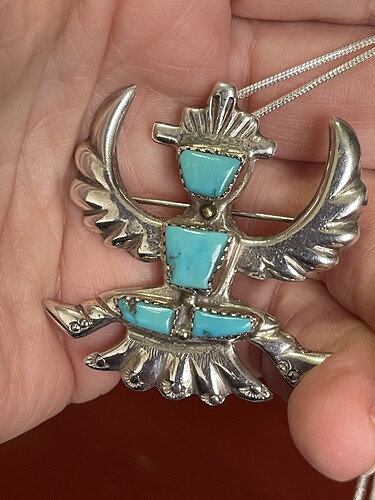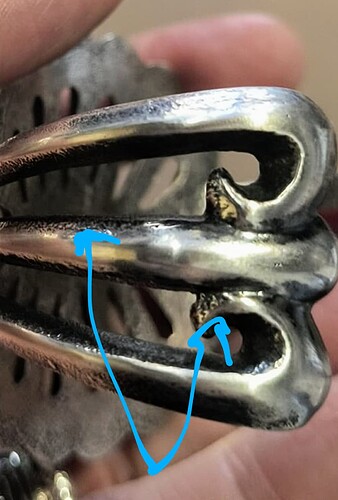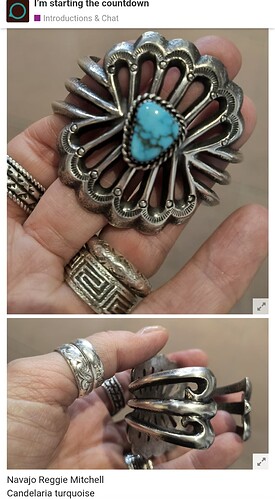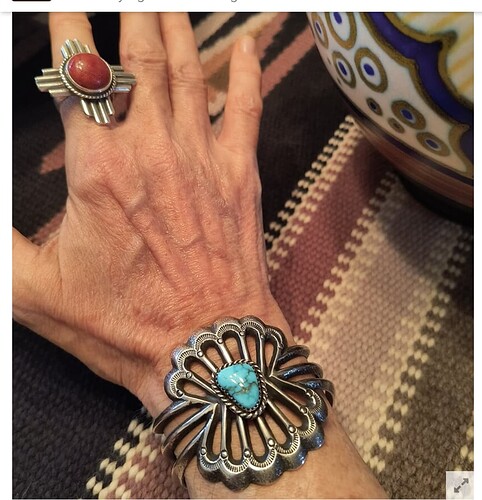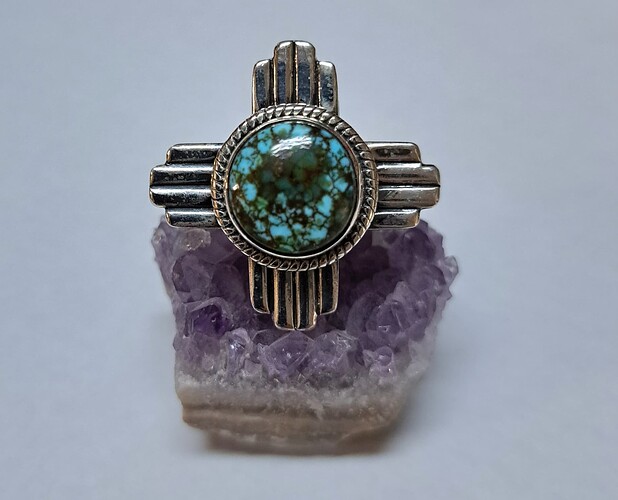@chicfarmer Lol, yes, because you are there and the contents are here? 
Oh thanks for starting the packing process. I’m sure that you will be padding the Ester Wood necklace well.
WHAT A WONDERFUL CHRISTMAS PRESENT! 




What a great box, and what a stash…wooza, wooza, wooza !!!
Thanks for posting.
Actually, every time I see this phrase, I get Lesley Gore’s “Sunshine, Lollipops and Rainbows” going through my head…
I have a knifewing! It’s a pin/pendant. According to the mark, it was made by Lupe Iule.
Newbie question: is this tufa cast? If you look closely, you can see some pitting around the wings near the torso. Mostly, though, the silver is very smooth.
@chamekke I just looked up Lupe Iule in my Hougart’s 3rd edition NA/Southwestern hallmarks book. States Ms. Iule is Zuni & active 1930s-1980s. Cast crosses is listed as her work. Maybe her knifewing pin/pendant is cast work. (Though I’m not sure that it’s tufa cast. Tufa cast work has a different look to me.)
So maybe sand cast instead of tufa cast? Tufa cast looks more textured than this.
@Patina @Ziacast thank you for your kind responses. I always get sand cast mixed up with tufa cast! I’m sure you’re right about this being [sand?] cast. One of these days I really need to read up on these different production methods so that I can recognize them.
I was curious about Lupe Iule (as you know, she was the wife of Horace Iule) and tried to research her, but couldn’t find a lot of info. One B&W photo on the Adobe Gallery website, which you can see here. Best known for her crosses, as you say, @Patina . Her birth year was 1916 but I could find no record of her death; if she’s alive now, she’s 107 or 108 years old!
The stones in this pendant are brighter and more saturated than my photo captured. I’ll try again sometime.
@chamekke My Hougarts 3rd edition book shows only her birth year - 1916. The same info that you have.
I just wanted to add that while we think of tufa casting as having that rough tufa texture, I don’t think we can reliably use that to distinguish tufa from sand cast. In fact, I’ve made a bit of a study of this, and I haven’t come up with any way yet to reliably distinguish tufa from sand cast. If anyone does know of a way I would love to hear it. Of course, we also have to consider that some items may be spin cast.
As far as tufa vs. sand, I believe that a lot of the earliest Native casting was tufa cast (or perhaps hand carved into different types of rock), but it was common for the rough texture to be filed away after casting. I think it is currently in vogue to leave the texture but that wasn’t always the case, and a lot of signs of casting can be modified in finishing. At Santa Fe Indian market one time I saw a concho belt made of multiple identical conchos with tufa texture. I asked the artist how he made it, and he said the original concho was tufa cast and the remainder were sandcast copies. So making sand cast copies of an original with tufa texture will replicate that texture.
Some artists are known for their tufa casting, and will even show or give you the mold, which I guess is the best way to know for sure. Artists that tend to have a higher output often in multiples of the same designs that they are known for, and with a slightly lower price point, are usually making sand cast multiples of their originals. So far I have not determined a way to differentiate sand from tufa cast by looking at the piece. My guess is that these Iule pendants are either sand cast or maybe even spin cast.
This thread has some useful info and a good article about the difference by @Jason:
@OrbitOrange Thank you for your posts. I’ll be the first to admit that I’ve always considered tufa cast work to be textured with a certain identifiable “look”. Sandcast items to me are smooth & maybe even a little rustic looking. As you can tell, I’ve used my visual & tactile senses without any thought to the technical aspects of the work. Now, I’ve never even heard of spin cast…
Yes, thank you OO! I had been going by what I was told by different shop owners/traders through the years. I asked Jeff Ogg if one of the cuffs I bought from him was sandcast, and he said yes (it was different looking from my pieces I know are tufa cast). Reggie Mitchell also talked to me at the Art Market about tufa casting, and seemed to imply there was a difference, but I probably didn’t understand. I need to read through that thread again; thanks for the link.
Thank you @OrbitOrange for your posts and the link, as well as the comment on the Iule pendants. This is most kind and helpful.
[quote
As far as tufa vs. sand, I believe that a lot of the earliest Native casting was tufa cast (or perhaps hand carved into different types of rock), but it was common for the rough texture to be filed away after casting. I think it is currently in vogue to leave the texture but that wasn’t always the case
[/quote]
I think I know what you are talking about here. Mr. Mitchell mentioned that he likes to leave part of the tufa texture on the top of his cuffs to show how they are made. Like here on mine…
@Ziacat Oh please show the rest of your Mitchell bracelet. I feel like you’ve posted it before, but it never hurts to see it again.
Sure! Here are some pics I posted in another thread last summer. I spent more on this cuff than any others I own, but it was worth it for me (plus I think my days of amazing price finds on cuffs may be over; my go-to shops are mostly closed ![]() ).
).
You wear it well. Thank you for posting this beauty!
That’s a beautiful cuff @Ziacat. I’m a big fan of stampwork on NA/SW jewelry. Wonderful piece of turquoise, too. I couldn’t resist when I saw your Zia symbol ring ![]() . Sonoran Gold turquoise.
. Sonoran Gold turquoise.
Love it! You have good taste ![]() I think Sonoran Gold is beautiful with that blue to green fade.
I think Sonoran Gold is beautiful with that blue to green fade.
Do you know who made yours? Mine is by Robert Yellowhorse. I bought it at Palms Trading in ABQ, and the owner said Mr. Yellowhorse had just been in, and sold him the rings right before we got there. Too bad I missed meeting the artist!
